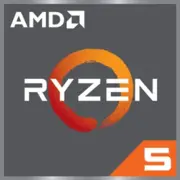AMD Ryzen 5 5500X3D

AMD Ryzen 5 5500X3D: A Hybrid of Affordability and Gaming Power
April 2025
Key Features: Architecture and Main Characteristics
The AMD Ryzen 5 5500X3D is a fresh solution for gamers and enthusiasts looking to get the most out of the aging AM4 platform. Despite AMD's transition to AM5 and DDR5, the 5500X3D remains relevant due to its unique 3D V-Cache technology.
Architecture and Process Technology
- Codename: Vermeer (Zen 3).
- Process Technology: 7 nm (optimized version for reduced heat output).
- Cores/Threads: 6/12.
- Frequencies: 3.0 GHz (base), up to 4.0 GHz in turbo mode.
- Cache: 96 MB L3 (of which 64 MB is 3D-stacked).
- TDP: 105 W.
Key Features
- 3D V-Cache: The increased L3 cache of up to 96 MB significantly speeds up performance in games and applications with high volumes of random data.
- AM4 Compatibility: An inexpensive upgrade for owners of older systems.
- Energy Efficiency: Despite a TDP of 105 W, the processor efficiently handles loads thanks to the optimized 7nm process.
Performance
In games such as Cyberpunk 2077 or Starfield, the 5500X3D shows a performance increase of up to 15-20% compared to the Ryzen 5 5600X, thanks to its cache. In multi-threaded tasks (rendering in Blender, streaming), it falls short of 8-core models, but it delivers respectable results for its price.
Compatible Motherboards
The Ryzen 5 5500X3D uses the AM4 socket, allowing it to be installed on motherboards with B550, X570, and even B450 chipsets (after BIOS update).
Choosing Recommendations
- B550: Optimal choice (for example, MSI B550 Tomahawk, $120–150). Supports PCIe 4.0 and memory overclocking up to 4000+ MHz.
- X570: For enthusiasts (ASUS ROG Strix X570-E, $200–250). Offers better VRM cooling and more ports.
- B450: Budget option (ASRock B450 Steel Legend, $80–100). Requires a BIOS update, but suitable for basic builds.
Features
- No support for PCIe 5.0 — a limitation of the AM4 platform.
- To activate full RAM frequency, check the motherboard's QVL.
Supported Memory
The processor works only with DDR4.
Recommendations
- Optimal Frequency: 3600 MHz (for example, Corsair Vengeance LPX 16 GB, $50–60).
- Timings: CL16 or lower to minimize latency.
- Volume: 16 GB is the minimum for gaming, 32 GB for work tasks.
Important: X3D chips are less sensitive to memory speed due to the large cache, so RAM overclocking won't result in significant gains.
Power Supply: Calculation and Recommendations
With a TDP of 105 W and using a discrete graphics card (e.g., NVIDIA RTX 4060 or AMD RX 7600 XT), the minimum power supply wattage is 550 W.
Tips
- Budget Builds: EVGA 600 BR (600 W, $60) — a reliable choice for non-overclocked systems.
- Powerful GPUs: If using an RTX 4070 Ti or higher, choose power supplies rated at 750 W (Corsair RM750x, $110).
- Certification: 80+ Bronze or higher.
Pros and Cons of Ryzen 5 5500X3D
Pros
- Outstanding gaming performance thanks to 3D V-Cache.
- Low entry cost (the processor is priced at $240–270, motherboards from $80).
- Supports PCIe 4.0 on B550/X570 chipsets.
Cons
- No support for DDR5 and PCIe 5.0.
- Maximum frequency is limited to 4.0 GHz — falls behind the Ryzen 5 7600 in work tasks.
- High heat output under load (requires a good cooler).
Use Cases
1. Gaming: Ideal for Full HD and 1440p. In Elden Ring or Call of Duty: Warzone, it achieves stable 100+ FPS.
2. Work Tasks: Suitable for video editing in DaVinci Resolve, working in Photoshop, but not for heavy 3D rendering.
3. Multimedia: Streaming via OBS with NVENC or AMD Encoder does not critically burden the CPU.
Comparison with Competitors
- AMD Ryzen 5 7600 (AM5): Faster in multi-threaded tasks (+25%), but more expensive (processor — $300, DDR5 + motherboard — +$150).
- Intel Core i5-13400F: Comparable in games but lags in multi-threading. Price — $220.
- AMD Ryzen 7 5800X3D: Best choice for AM4 (8 cores, $320), but overkill for most gaming scenarios.
Conclusion: The 5500X3D excels against competitors in the budget AM4 segment due to its cache.
Practical Assembly Tips
1. Cooling: Use a tower cooler with heat pipes (DeepCool AK620, $60).
2. Case: Minimum of 2 fans for ventilation (Phanteks Eclipse P300, $70).
3. Graphics Card: Avoid pairing with GPUs above RTX 4070 — it will create a bottleneck.
4. Memory: 3600 MHz CL16 + dual-channel setup.
Final Conclusion: Who is Ryzen 5 5500X3D For?
This processor is an ideal choice for:
- AM4 Gamers looking to upgrade without changing the motherboard.
- Budget Builds focused on gaming rather than professional tasks.
- Streamers utilizing GPU encoding.
Why this one? For $240–270, you get gaming performance at the level of the Ryzen 7 5800X3D but at a lower cost. If you're not ready to move to AM5 and DDR5 — this is the best solution in 2025.
Prices are current as of April 2025. They are for new devices in retail stores in the USA.
Basic
CPU Specifications
Memory Specifications
GPU Specifications
Miscellaneous
Related CPU Comparisons
Share in social media
Or Link To Us
<a href="https://cputronic.com/cpu/amd-ryzen-5-5500x3d" target="_blank">AMD Ryzen 5 5500X3D</a>


